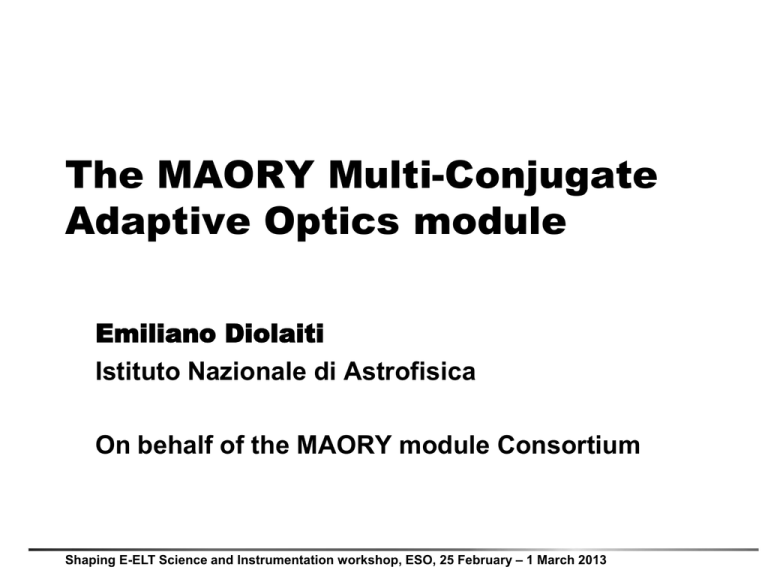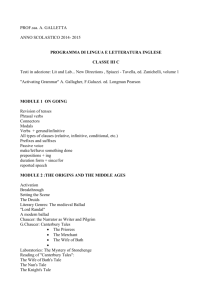The MAORY MCAO module for the E-ELT
advertisement

The MAORY Multi-Conjugate Adaptive Optics module Emiliano Diolaiti Istituto Nazionale di Astrofisica On behalf of the MAORY module Consortium Shaping E-ELT Science and Instrumentation workshop, ESO, 25 February – 1 March 2013 Requirements (from Phase A) Multi conjugate Adaptive Optics RelaY – Compensate atmospheric turbulence – Relay telescope focal plane to science instrument Main requirements related to client instrument MICADO – – – – Wavelength range 0.8-2.4 µm Field of view 53" 53" Uniform adaptive optics correction with high sky coverage Gravity invariant exit port with field derotation Other requirements – MCAO module to be placed on E-ELT Nasmyth platform – Lateral exit port for another possible instrument TBC Shaping E-ELT Science and Instrumentation workshop – The MAORY MCAO module 2 Multi-Conjugate Adaptive Optics Strehl Ratio maps @K (2.2 µm) MCAO demonstrated by MAD on VLT SCAO MCAO All pictures © European Southern Observatory Shaping E-ELT Science and Instrumentation workshop – The MAORY MCAO module 3 Module architecture E-ELT MAORY Client Instrument Telescope Control System E-ELT Signal (real-time) Signal (non real-time) Common Path Optics Deformable Mirrors Light beam Real Time Control System Dichroic Science Path Optics LGS Objective NGS Wavefront Sensor LGS Wavefront Sensor MAORY Instrumentation Software Exit Port MAORY module Client Instrument Instrumentation Software Shaping E-ELT Science and Instrumentation workshop – The MAORY MCAO module 4 Module layout Pre-focal station Nasmyth platform MAORY Lateral port Area for detached instrument Shaping E-ELT Science and Instrumentation workshop – The MAORY MCAO module MICADO Gravity invariant port 5 Post-focal relay optics Science path Laser guide star path Alternative optical design under discussion Light beam from E-ELT Gravity invariant exit port Two post-focal deformable mirrors Baseline piezo-electric actuator technology under review Shaping E-ELT Science and Instrumentation workshop – The MAORY MCAO module 6 LGS Wavefront Sensor Why Laser Guide Stars? Sodium layer data kindly provided by Paul Hickson, University of British Columbia Sky coverage and performance uniformity Demonstrated by GeMS on Gemini Telescope in MCAO mode LGS Wavefront Sensor description 6 Sodium Laser Guide Stars Wavefront Sensor type: Shack-Hartmann (~80 80 subapertures, 500 fps) Sodium layer and LGS issues Finite distance multiple LGS Tilt indetermination Natural stars required Sodium density profile is structured and variable in time Natural stars required Shaping E-ELT Science and Instrumentation workshop – The MAORY MCAO module 7 NGS Wavefront Sensor 3 Stars over 2.6 arcmin field of view Limiting magnitude H 21-22 Each probe split into two channels Tip-Tilt & Focus channel Wavelength range 1.5-1.8 µm 100-500 Hz frame rate To MICADO Required stars Reference channel Wavelength range 0.6-0.9 µm Prevent propagation of spurious signals seen by LGS wavefront sensor Measure low-medium order modes at slow frame rate (~0.1 Hz) Engineering mode: Full Natural Guide Star wavefront sensing at fast rate Shaping E-ELT Science and Instrumentation workshop – The MAORY MCAO module 8 Adaptive optics performance MICADO field Ks 2.16µm H 1.65µm J 1.215µm I 0.9µm Strehl Ratio Strehl Ratio Median atmospheric conditions (seeing 0.8") Distance from field center [arcsec] Sky coverage Galactic Pole Minimum field-averaged Strehl Ratio (53" 53") 2.16 µm 1.65 µm 1.215 µm 0.9 µm Ks band H band J band I band 0.53 0.34 0.14 0.03 0.51 0.32 0.13 0.03 0.41 0.22 0.06 <0.01 Shaping E-ELT Science and Instrumentation workshop – The MAORY MCAO module % Sky 39% 50% 80% 9 Half-light radius Half light radius [mas] Seeing 0.8 arcsec Seeing 0.6 arcsec Ks 2.16µm H 1.65µm Ks 2.16µm H 1.65µm J 1.215µm J 1.215µm I 0.9µm I 0.9µm Distance from field center [arcsec] Distance from field center [arcsec] Shaping E-ELT Science and Instrumentation workshop – The MAORY MCAO module 10 Ensquared Energy Ensquared Energy 75 75 mas2 Seeing 0.8 arcsec Seeing 0.6 arcsec Ks 2.16µm H 1.65µm Ks 2.16µm H 1.65µm J 1.215µm J 1.215µm I 0.9µm I 0.9µm Distance from field center [arcsec] Distance from field center [arcsec] Shaping E-ELT Science and Instrumentation workshop – The MAORY MCAO module 11 Project overview Phase A study Nov 2007 – Dec 2009 MCAO module approved by ESO as part of first-light instrumentation to serve E-ELT diffraction-limited camera MICADO Project plan for next phases under consolidation – Negotiations between ESO and INAF (lead institute) are well advanced – INAF is supporting the project through its Directorate of Science Shaping E-ELT Science and Instrumentation workshop – The MAORY MCAO module 12 Project overview Current Consortium organisation – INAF (Lead Institute, System responsibility, sub-systems: platform, NGS WFS, deformable mirrors procurement, auxiliary equipments, science support tools) – Durham University (Real Time Control System) – Observatoire de Paris LESIA (LGS wavefront sensor) – ESO (wavefront sensor cameras, deformable mirrors development TBC) Preliminary project schedule Y01 Y02 Y03 Y04 Y05 Y06 Y07 Y08 Y09 Y10 Phase B Phase C Phase D Phase E On-going preparatory activities with dedicated funds awarded to INAF by Italian Ministry for Research Shaping E-ELT Science and Instrumentation workshop – The MAORY MCAO module 13 Integration room preparation Mechanical Workshop Shaping E-ELT Science and Instrumentation workshop – The MAORY MCAO module 14
